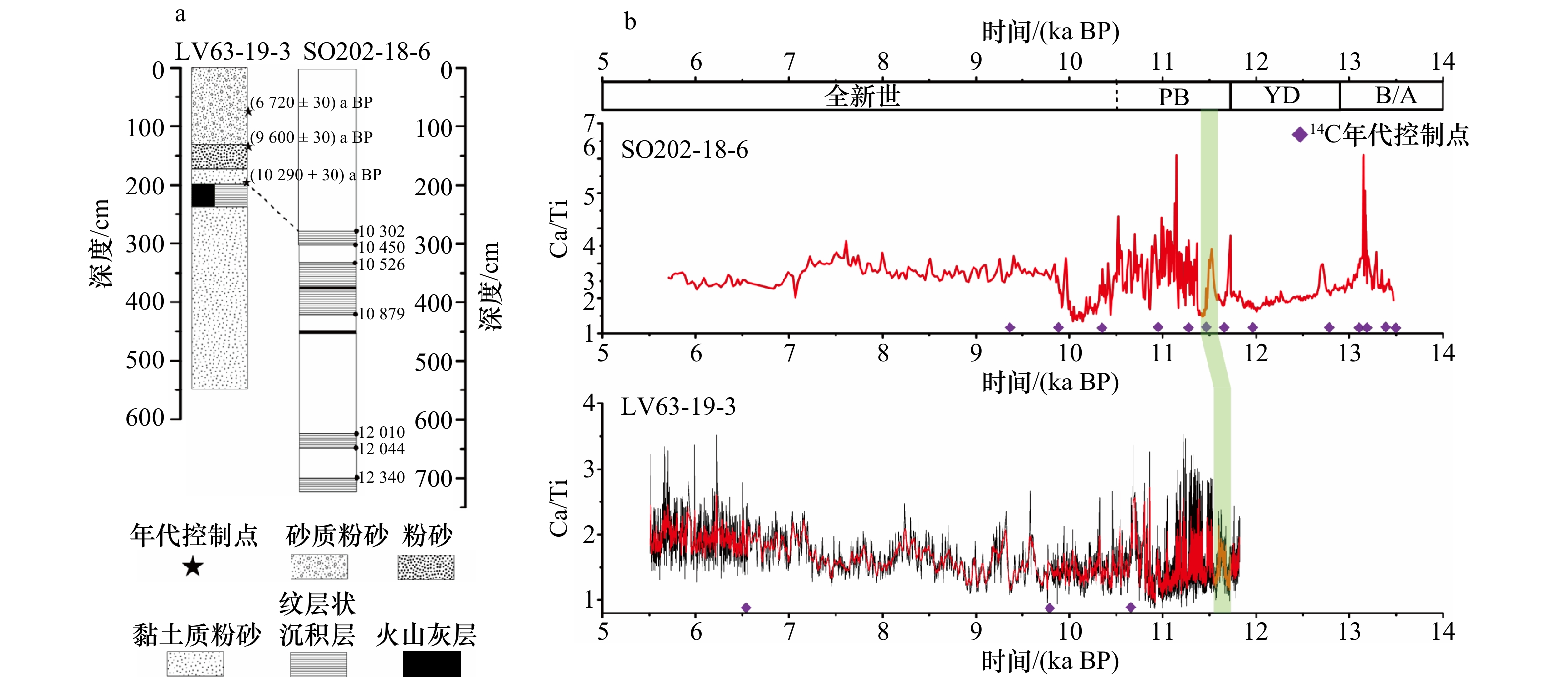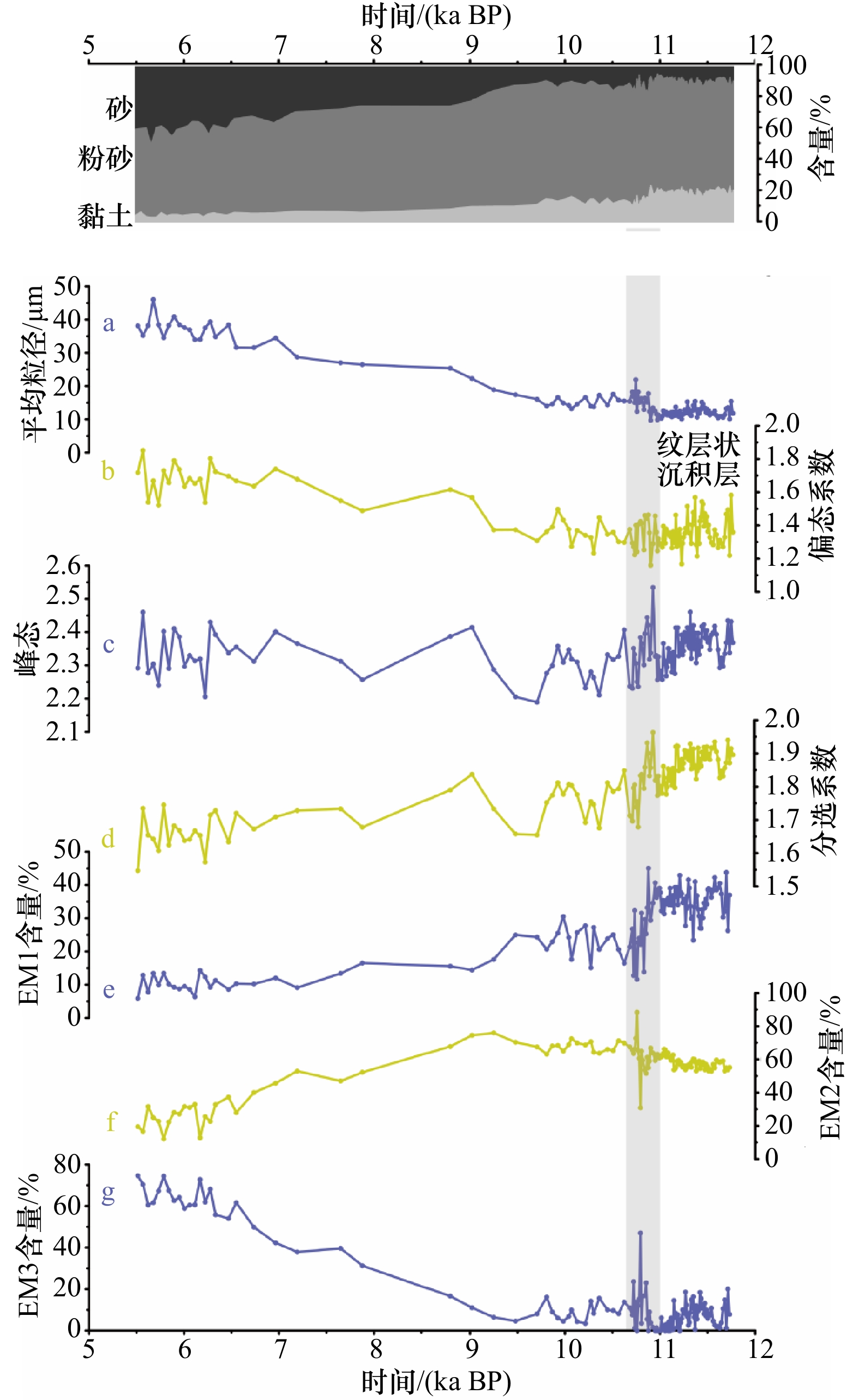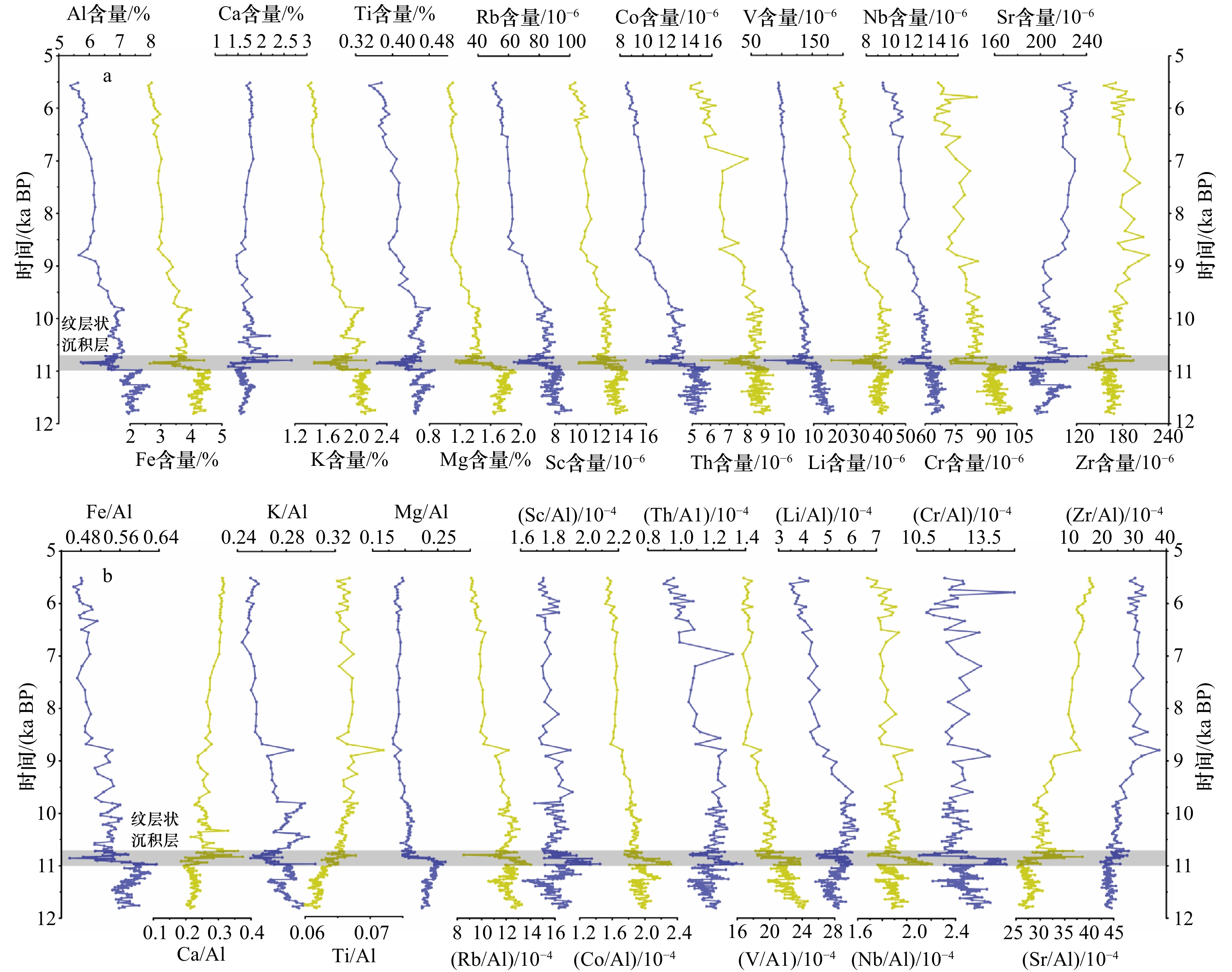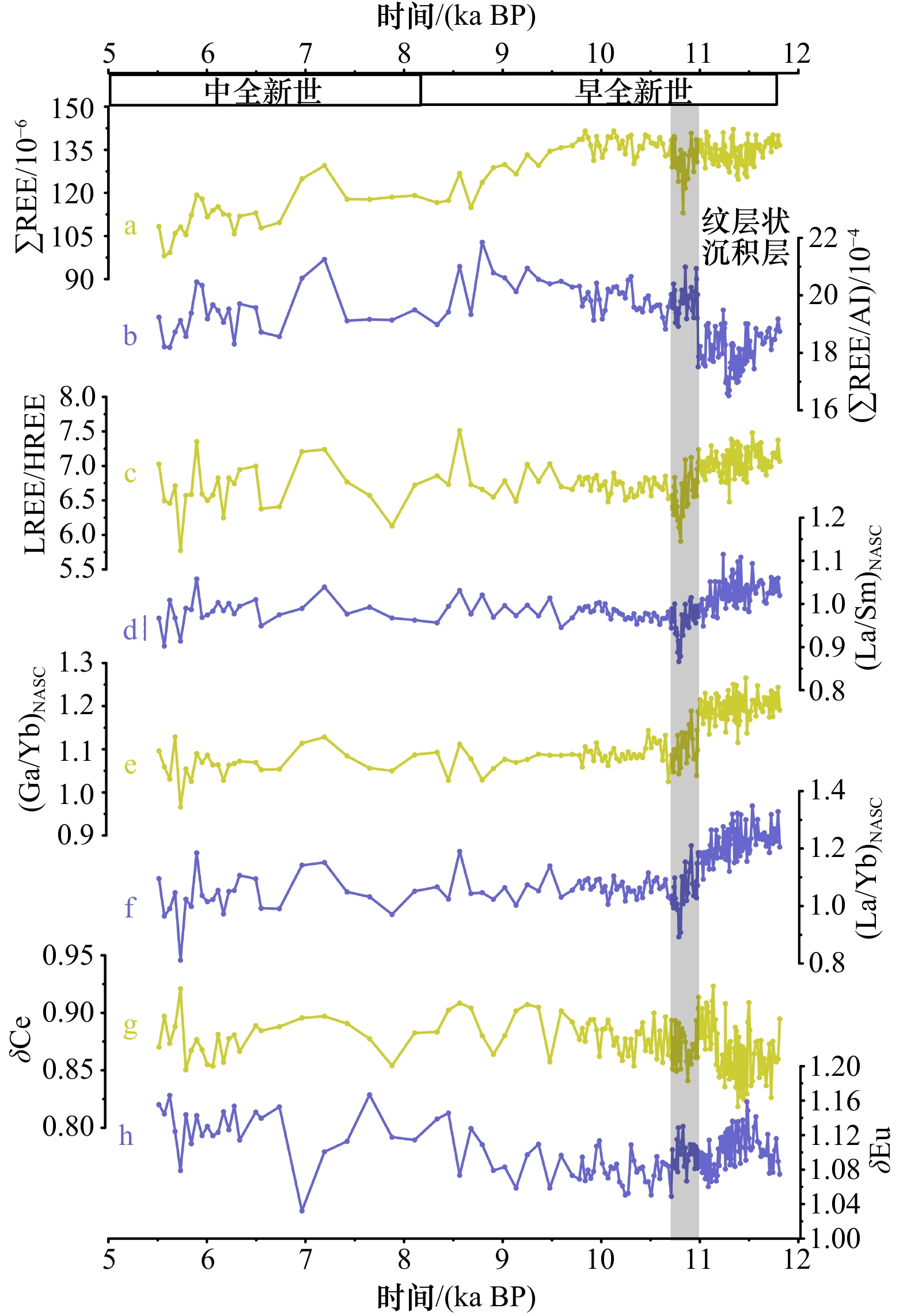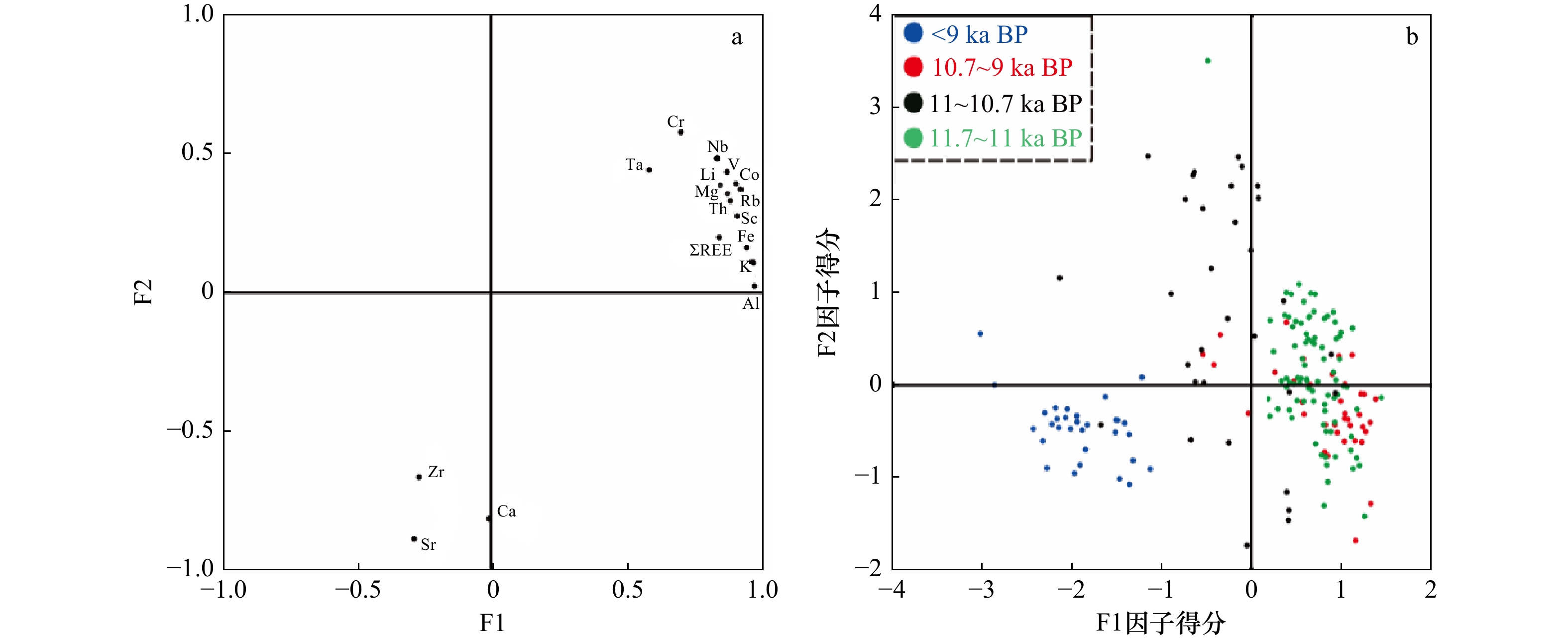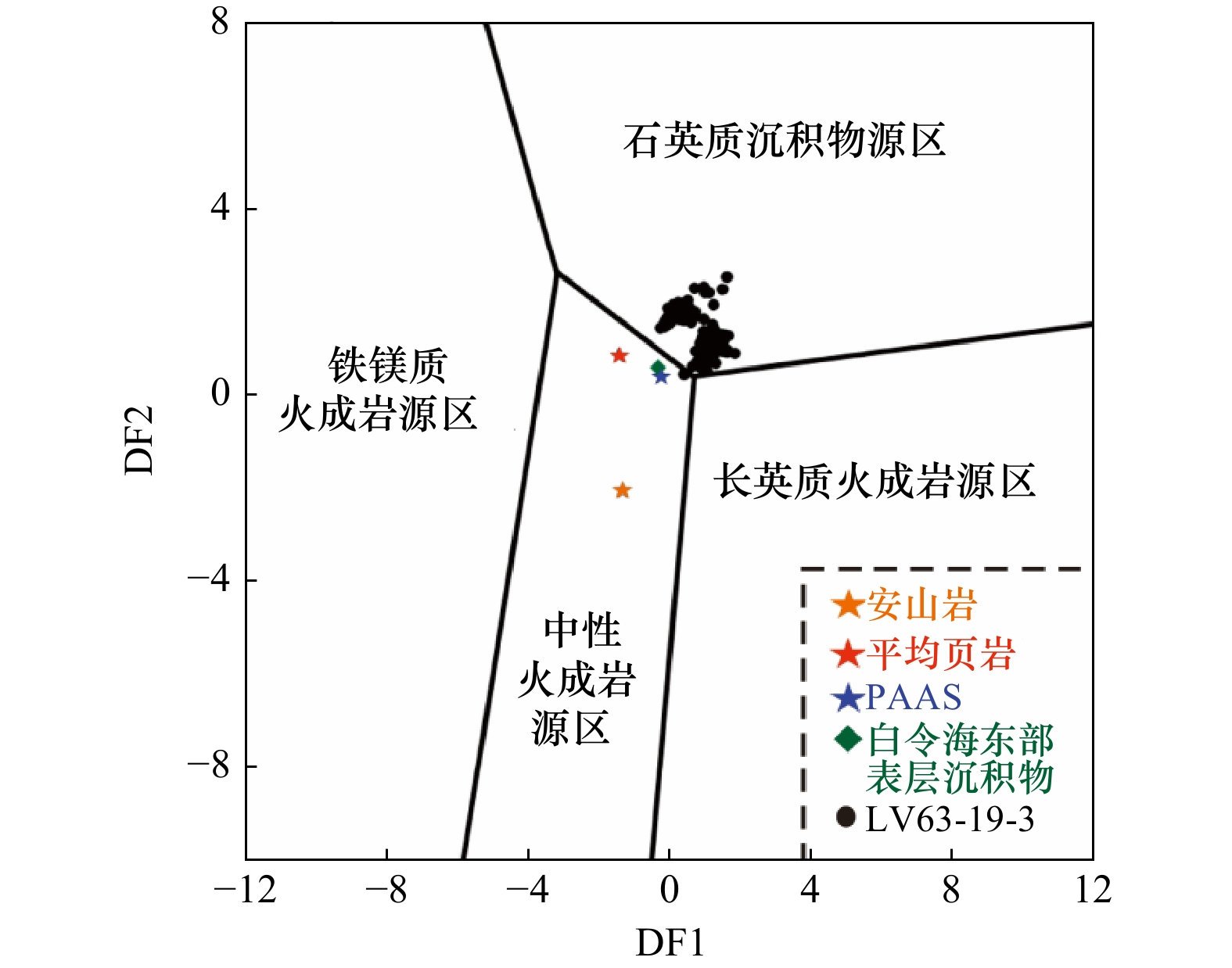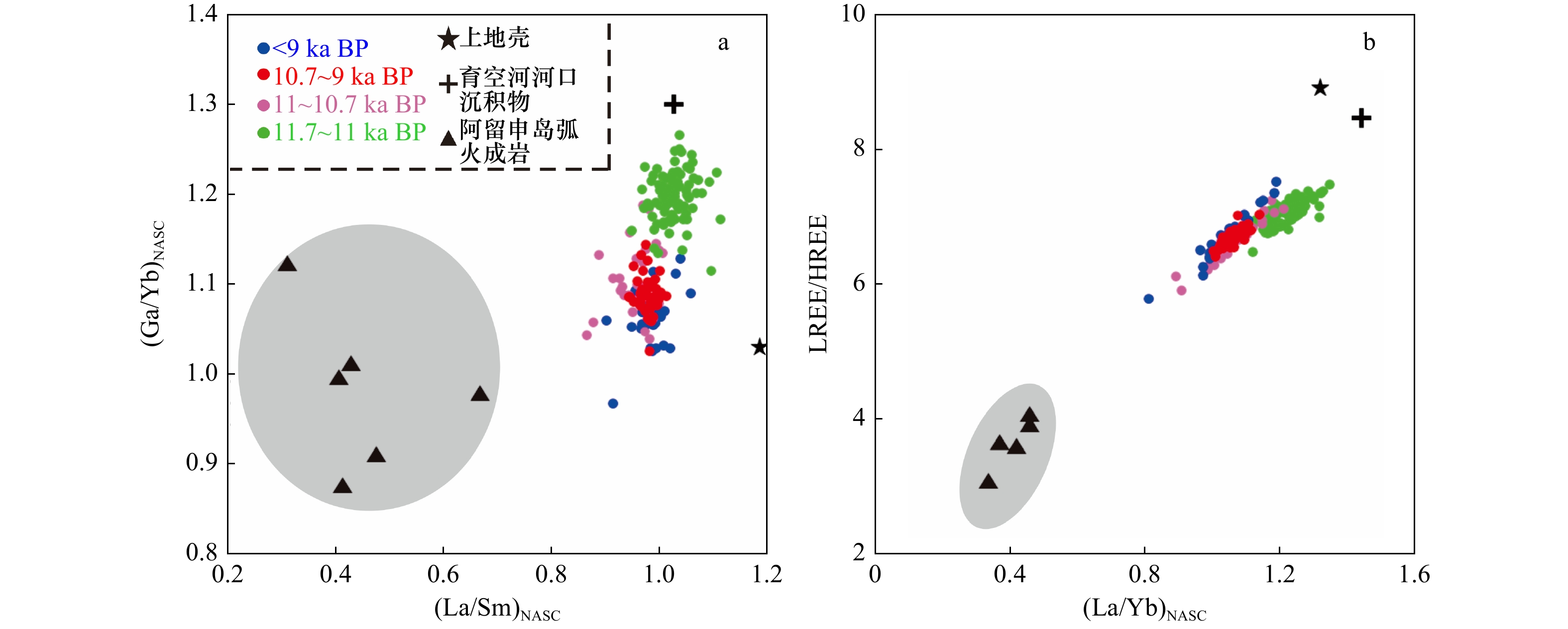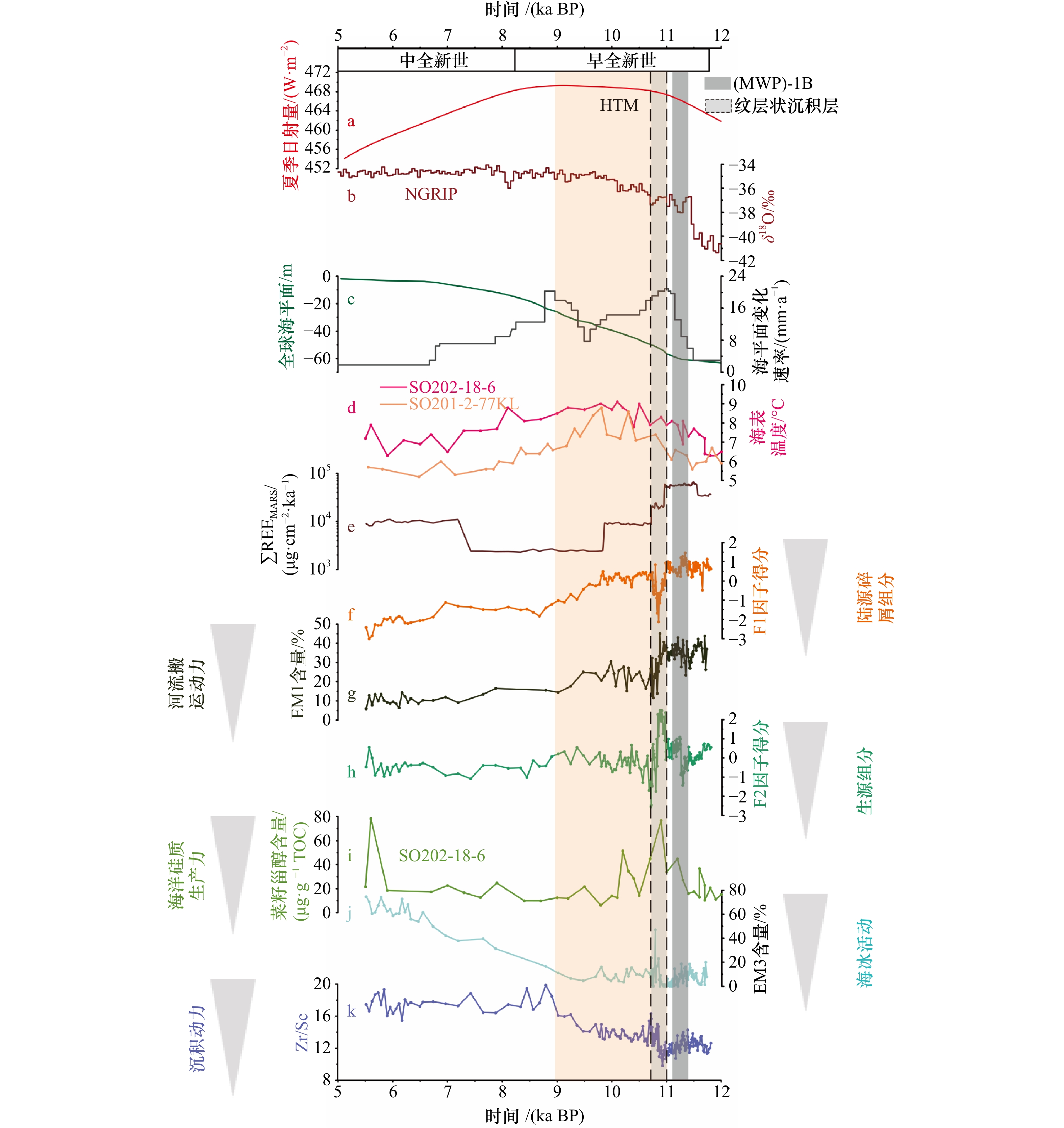Rapid changes in sedimentary environment on the northern slope of the Bering Sea during the early Holocene
-
摘要: 理解增暖背景下海洋环境的演化过程是海洋学和气候学一项重要的研究内容。在地质时期,地球经历了多次增暖时段(包括早全新世),这为认识海洋环境演化过程提供了重要参考。早全新世全球气候经历了快速增暖,并伴随着冰原融化和海平面快速上升,对包括白令海在内的高纬边缘海的沉积过程和海洋环境产生显著影响。白令海发育宽阔的大陆架,毗邻北美大陆,接受来自育空河、阿纳德尔河和库斯科维姆河物质的供给。目前我们对白令海如何响应早全新世气候的认识还存在明显不足。本研究对位于白令海北部陆坡LV63-19-3岩心沉积物中陆源碎屑组份进行了高分辨率调查,结合沉积年龄模型,研究了早中全新世(距今11.7~5.5 ka)白令海北部陆坡陆源沉积演化过程。研究结果显示,在距今11.5~11 ka,白令海北部陆坡沉积速率高达392.9 cm/ka,在距今约9.7 ka以后降至17.2 cm/ka。在距今11~10.7 ka,发现一层厚约40 cm的暗色纹层状沉积层。在高沉积速率时段,沉积物平均粒径较细,距今9 ka以来平均粒径逐渐增大。主微量元素分析结果表明,陆源碎屑沉积物母岩性质以长英质沉积物为主,并存在少量火山碎屑源贡献。白令海北部陆坡高沉积速率事件对应于冰原融水脉冲(MWP)-1B事件(距今11.4~11.1 ka),并导致白令海陆坡硅质生产力勃发。在距今11~10.7 ka研究区春夏季海冰覆盖增加抑制表层水体氧供给,夏、秋季持续冰川融水和高表层生产力进一步加剧了水体层化和海洋内部消耗,共同促进了纹层状沉积层的形成。距今9 ka以来白令海季节性海冰活动增强,但是陆源碎屑物质质量累积速率则逐渐减小,表明随着海平面上升,供给到研究区的陆源物质减少。我们认为早全新世白令海北部陆坡沉积环境快速变化是海平面、冰融水脉冲事件和季节性海冰活动共同作用的结果,实际上受高纬日射量、北美大陆冰原融化和全球气候变化控制。Abstract: It has been an important research topic in oceanography and climatology to understand the evolution of marine environment in the context of anathroprogenic warming. In the geological past, the Earth has experienced several warming periods (including the early Holocene), which provide natural analogs for future climate. The global climate experienced rapid warming during the early Holocene, accompanied by ice sheet melting and rapid sea level rise, which have significantly impacted sedimentary processes and marine environment in high-latitude marginal seas, including the Bering Sea. The Bering Sea consists of a broad continental shelf, adjacent to the North American continent, and receives material supplies from the Yukon River, Anadyr River and Kuskokwim River. There are still significant gaps in our understanding of how the Bering Sea responds to the early Holocene climate. In this study, high-resolution analysis of major and minor elements in bulk sediments of Core LV63-19-3 retrieved from the northern slope of the Bering Sea, in combination with a well-constrained sedimentary age model to investigate the sedimentary environment changes on the northern Bering Sea slope during the early to middle Holocene (11.7–5.5 ka BP). The results show that the sedimentation rate on the northern continental slope of Bering Sea was as high as 392.9 cm/ka during 11.5–11 ka BP, and decreased rapidly to 17.2 cm/ka after 9.7 ka BP. At 11–10.7 ka BP, a dark laminated sediment layer about of 40 cm thick was found. In the period of high sedimentation rate, the average grain size of sediments was finer, and increased gradually after 9 kaBP. Both major and minor element concentrations indicate that the lithological properties of terrigenous clastic sediments were mainly felsic sediments with a small amount of pyroclastic contributions. The high sediment rate corresponds to the Meltwater Pulse-1B event (11.4–11.1 ka BP) and resulted in a blooming of siliceous productivity on the Bering Sea continental slope. In the study area from 11 ka BP to 10.7 ka BP, the increase in seasonal sea ice coverage inhibited the oxygen supply from the atmosphere to surface water and subsequent transport to the bottom water, while the glacial meltwater and the persistent high productivity in summer and autumn further exacerbated the surface water stratification and ocean interior oxygen consumption on the continental slope of the Bering Sea, both of which together triggered the formation of laminated sediment. After 9 ka BP, the seasonal sea ice activity in the Bering Sea increased gradually, but the mass accumulation rate of terrigenous detrital materials decreased, indicateing a decrease in the supply of terrigenous materials to the study area along with sea level rise. We suggest that the rapid shift in early Holocene sedimentary environment on the northern Bering Sea continental slope is the result of a combination of sea level, Meltwater Pulse 1B event and seasonal sea ice activity, which is actually controlled by high-latitude solar insolation, North American ice sheet melting, and global climate.
-
图 1 研究站位和白令海现代表层环流示意图
彩色实线表示白令海表层环流;黑色虚线表示末次盛冰期白令海海岸线,此时白令陆架暴露[35];蓝色虚线表示白令海低海平面时期河流的潜在路径[35]
Fig. 1 Study location and schematic of modern surface circulation in the Bering Sea
The solid colored line indicates the surface circulation of the Bering Sea; the black dashed line indicates the Bering Sea coastline during the Last Glacial Maximum, when the Bering Shelf was exposed[35]; the blue dashed line indicates the potential path of the river during low sea level in the Bering Sea[35]
图 2 LV63-19-3与SO202-18-6岩心[28]岩性比对(a),LV63-19-3和SO202-18-6岩心[28]基于XRF扫描的Ca/Ti比值比对(b)
黑线是原始数据,红线是10点滑动平均。浅绿条带代表LV63-19-3岩心与SO202-18-6岩心年代控制点比对
Fig. 2 Lithology correlation between cores LV63-19-3 and SO202-18-6[28] (a), and comparison of Ca/Ti ratios based on XRF core scanning from cores LV63-19-3 and SO202-18-6[28] (b)
The black line is the original data and the red line is the 10-point moving average. The light green band represents the comparison of age control points between Core LV63-19-3 and Core SO202-18-6
图 6 稀土元素(REE)含量及其参数时间序列
垂直灰色阴影条带表示纹层状沉积层;(La/Sm)NASC、(Ga/Yb)NASC和(La/Yb)NASC为北美页岩[41]标准化计算结果;δCe和δEu为北美页岩标准化计算结果: ${ \mathrm{\delta }\mathrm{Ce}=\dfrac{{\mathrm{Ce}}_{\mathrm{NASC}}}{\sqrt{\left({\mathrm{La}}_{\mathrm{NASC}}\right)\cdot \left({\mathrm{Pr}}_{\mathrm{NASC}}\right)}}}$, ${\mathrm{\delta }\mathrm{Eu}=\dfrac{{\mathrm{Eu}}_{\mathrm{NASC}}}{\sqrt{\left({\mathrm{Sm}}_{\mathrm{NASC}}\right)\cdot \left({\mathrm{Gd}}_{\mathrm{NASC}}\right)}}}$
Fig. 6 Time series of rare earth element (REE) parameters
Vertical gray bar indicates laminated sediments; (La/Sm)NASC、(Ga/Yb)NASC and (La/Yb)NASC are normalized for North American shale composite [41]; δCe and δEu are normalized for North American shale composite: ${ \delta {\rm{Ce}}= \dfrac{{\rm{Ce}}_{\rm{NASC}}}{\sqrt{\left({\mathrm{La}}_{\mathrm{NASC}}\right)\cdot \left({\mathrm{Pr}}_{\mathrm{NASC}}\right)}} }$, ${\delta \mathrm{Eu}= \dfrac{{\mathrm{Eu}}_{\mathrm{NASC}}}{\sqrt{\left({\mathrm{Sm}}_{\mathrm{NASC}}\right)\cdot\left({\mathrm{Gd}}_{\mathrm{NASC}}\right)}}}$
图 9 北美页岩标准化稀土配分模式
育空河河口沉积物数据引自文献[33],白令海北坡沉积物数据引自文献[50],阿留申岛弧火成岩数据引自文献[51]
Fig. 9 North American shale composite (NASC) normalized rare earth elements patterns
The data for Yukon River Estuary sediments were cited from reference [33],sediments from the northern slope of the Bering Sea were cited from reference [50], and Aleutian Island Arc igneous rock were cited from reference [51]
图 10 LV63-19-3岩心(La/Sm)NASC与(Ga/Yb)NASC、(La/Yb)NASC与LREE/HREE散点图
育空河河口沉积物数据引自文献[33],阿留申岛弧火成岩数据引自文献[51]
Fig. 10 Scatter plots between (La/Sm)NASC vs. (Ga/Yb)NASC, (La/Yb)NASC vs. LREE/HREE in Core LV63-19-3
The data for Yukon River Estuary sediments were cited from reference [33], Aleutian Island Arc igneous rock were cited from reference [51]
图 11 早全新世白令海陆坡沉积动力时间序列
a. 65°N夏季太阳辐射量 [2];b. SO202-18-6岩心和SO201-2-77KL海表温度[24];c. LV63-19-3岩心平均粒径;d. LV63-19-3岩心Zr/Sc比值;e. LV63-19-3岩心EM3含量;f. BR-07岩心PBIP25和PDIP25指数[56];g. LV63-19-3岩心EM1含量;垂直橙色阴影条带表示HTM距今(11~9 ka)时期[30];垂直深色阴影条带表示冰融水(MWP)-1B事件(距今11.4~11.1 ka)[57] ;虚线标注的垂直浅色阴影条带表示纹层状沉积层
Fig. 11 Time series of sedimentary dynamics on the north slope of the Bering Sea during the early Holocene
a. Solar insolation in summer at 65°N [2]; b. Bering Sea sea surface temperature based on cores SO202-18-6 and SO201-2-77KL[24]; c. average particle size in Core LV63-19-3; d. Zr/Sc ratios in Core LV63-19-3; e. contents of EM3 in Core LV63-19-3; f. Core BR07 PBIP25 and PDIP25 indices[56]; g. contents of EM1 in Core LV63-19-3; orange vertical bar indicates the HTM (11–9 ka BP) period[30]; dark vertical bar indicates Meltwater Pulse (MWP)-1B event (11.4–11.1 ka BP) [57]; light vertical bar indicates laminated sediments
图 12 早全新世白令海陆坡LV63-19-3岩心沉积记录与其他古气候记录对比
a. 65°N夏季太阳辐射量[2];b. 格陵兰岛NGRIP冰芯δ18O记录[60];c. 全球海平面和海平面变化速率[31];d. SO202-18-6岩心和SO201-2-77KL海表温度[24];e. LV63-19-3岩心ΣREE质量通量;f. LV63-19-3岩心因子1(F1)得分;g. LV63-19-3岩心EM1含量;h. LV63-19-3岩心因子2(F2)得分;i. SO202-18-6岩心菜籽甾醇含量;j.LV63-19-3岩心EM3含量;k. LV63-19-3岩心Zr/Sc比值;垂直橙色阴影条带表示HTM(距今11~9 ka)时期[30];垂直深色阴影条带表示冰融水(MWP)-1B事件(距今11.4~11.1 ka)[57];虚线标注的垂直浅色阴影条带表示纹层状沉积层
Fig. 12 Comparison between sedimentary records of Core LV63-19-3 of the Bering Sea during the early Holocene and other paleoclimate records
a. Solar insolation in summer at 65°N [2]; b. greenland NGRIP ice core δ18O record[60]; c. global sea level and rate of sea level change[31]; d. Bering Sea sea surface temperature based on cores SO202-18-6 and SO201-2-77KL[24]; e. REEMARS in Core LV63-19-3; f. F1 factor score in Core LV63-19-3; g. contents of EM1 in Core LV63-19-3; h. F2 factor score in Core LV63-19-3; i. contents of Dinosterol (ug/g TOC) in Core SO202-18-6 ; j. contents of EM3 in Core LV63-19-3; k. Zr/Sc ratios in Core LV63-19-3; orange vertical bar indicates the HTM (11–9 ka BP) period[30]; dark vertical bar indicates Meltwater Pulse (MWP)-1B events (11.4–11.1 ka BP) [57]; light vertical bar indicates laminated sediments
表 1 LV63-19-3 岩心的年代控制点
Tab. 1 Age control points of Core LV63-19-3
表 2 LV63-19-3 岩心粒度端元参数特征
Tab. 2 Characteristics of the grain size of modeled end member of Core LV63-19-3
端元 平均粒径/μm 分选系数 偏态 峰态 黏土/% 粉砂/% 砂/% EM1 4.29 3.48 0.63 3.22 54.22 43.20 2.59 EM2 19.52 2.34 −0.06 2.73 4.03 88.93 7.05 EM3 64.24 1.89 −0.62 3.52 0.04 49.21 50.75 表 3 LV63-19-3岩心元素和平均粒径相关系数(R2)分析
Tab. 3 Correlation analysis for elements and mean particle size in Core LV63-19-3
Al Fe Ca K Ti Mg Rb Sc Co Th V Li Nb Cr Ta Sr Zr Al 1.00 Fe 0.91 1.00 Ca 0.01 0.03 1.00 K 1.00 0.88 0.03 1.00 Ti 1.00 0.78 0.01 0.87 1.00 Mg 1.00 1.00 0.12 0.77 0.64 1.00 Rb 0.76 0.80 0.10 0.85 0.75 0.79 1.00 Sc 0.77 0.83 0.07 0.80 0.73 0.78 0.87 1.00 Co 0.78 0.86 0.10 0.80 0.68 0.91 0.90 0.84 1.00 Th 0.61 0.64 0.08 0.72 0.69 0.63 0.87 0.72 0.78 1.00 V 0.75 0.79 0.16 0.78 0.60 0.89 0.88 0.78 0.91 0.73 1.00 Li 0.58 0.61 0.09 0.70 0.72 0.59 0.87 0.71 0.75 0.87 0.69 1.00 Nb 0.61 0.66 0.17 0.65 0.58 0.79 0.84 0.66 0.86 0.79 0.88 0.76 1.00 Cr 0.44 0.50 0.26 0.50 0.38 0.69 0.67 0.50 0.71 0.64 0.81 0.60 0.85 1.00 Ta 0.26 0.28 0.12 0.30 0.30 0.35 0.44 0.33 0.42 0.50 0.43 0.45 0.51 0.41 1.00 Sr 0.07 0.18 0.60 0.14 0.08 0.29 0.38 0.30 0.37 0.34 0.35 0.40 0.35 0.33 0.26 1.00 Zr 0.01 0.17 0.13 0.11 0.04 0.29 0.25 0.20 0.31 0.15 0.28 0.21 0.23 0.23 0.10 0.09 1.00 平均粒径 0.77 0.77 0.08 0.80 0.77 0.74 0.87 0.80 0.83 0.82 0.78 0.82 0.82 0.73 0.54 0.37 0.16 表 4 LV63-19-3 岩心沉积物元素因子旋转成分矩阵
Tab. 4 Rotated composition matrix of elemental factors of Core LV63-19-3
元素 因子1(F1) 因子2(F2) Al 0.964 0.024 K 0.960 0.107 Fe 0.935 0.161 Rb 0.912 0.368 Sc 0.901 0.273 Co 0.897 0.389 Th 0.872 0.336 Mg 0.867 0.354 V 0.863 0.430 Li 0.839 0.383 ΣREE 0.834 0.197 Nb 0.818 0.496 Cr 0.693 0.572 Ta 0.578 0.438 Sr −0.291 −0.883 Ca −0.011 −0.812 Zr −0.274 −0.663 方差/% 61.61 21.46 累计方差/% 61.61 83.07 注:加粗字体表示与因子显著相关的载荷值。 -
[1] IPCC. Climate change 2014: The Physical Science Basis: Contribution of Working Group I to the Fifth Assessment Report of the Intergovernmental Panel on Climate Change [M]. Cambridge: Cambridge University Press, 2014. [2] Berger A, Loutre M F. Insolation values for the climate of the last 10 million years[J]. Quaternary Science Reviews, 1991, 10(4): 297−317. doi: 10.1016/0277-3791(91)90033-Q [3] Rogelj J, Den Elzen M, Höhne N, et al. Paris Agreement climate proposals need a boost to keep warming well below 2℃[J]. Nature, 2016, 534(7609): 631−639. doi: 10.1038/nature18307 [4] IPCC. Climate change 2021: The Physical Science Basis: Contribution of Working Group I to the Sixth Assessment Report of the Intergovernmental Panel on Climate Change[M]. Cambridge: Cambridge University Press, 2021. [5] IPCC. Climate change 2007: The Physical Science Basis: Contribution of Working Group I to the Fourth Assessment Report of the Intergovernmental Panel on Climate Change[M]. Cambridge: Cambridge University Press, 2007. [6] Springer A M, Mcroy C P, Flint M V. The Bering Sea Green Belt: shelf-edge processes and ecosystem production[J]. Fisheries Oceanography, 1996, 5(3/4): 205−223. doi: 10.1111/j.1365-2419.1996.tb00118.x [7] Pelto B M. Sedimentological, Geochemical and Isotopic Evidence for the Establishment of Modern Circulation through the Bering Strait and Depositional Environment History of the Bering and Chukchi Seas during the Last Deglaciation[D]. Amherst: University of Massachusetts Amherst, 2014. [8] Broecker W S, Peng T H, Jouzel J, et al. The magnitude of global fresh-water transports of importance to ocean circulation[J]. Climate Dynamics, 1990, 4(2): 73−79. doi: 10.1007/BF00208902 [9] Wijffels S E, Schmitt R W, Bryden H L, et al. Transport of freshwater by the oceans[J]. Journal of Physical Oceanography, 1992, 22(2): 155−162. doi: 10.1175/1520-0485(1992)022<0155:TOFBTO>2.0.CO;2 [10] Johannessen O M, Muench R D, Overland J E. The Polar Oceans and Their Role in Shaping the Global Environment: the Nansen Centennial Volume[M]. Washington DC, USA: American Geophysical Union, 1994. [11] Keigwin L D, Cook M S. A role for North Pacific salinity in stabilizing North Atlantic climate[J]. Paleoceanography, 2007, 22(3): PA3102. [12] Stabeno P J, Bond N A, Kachel N B, et al. On the temporal variability of the physical environment over the south-eastern Bering Sea[J]. Fisheries Oceanography, 2001, 10(1): 81−98. doi: 10.1046/j.1365-2419.2001.00157.x [13] Sun Yechen, Xiao Wenshen, Wang Rujian, et al. Changes in sediment provenance and ocean circulation on the northern slope of the Bering Sea since the last deglaciation[J]. Marine Geology, 2021, 436: 106492. doi: 10.1016/j.margeo.2021.106492 [14] Rella S F, Tada R, Nagashima K, et al. Abrupt changes of intermediate water properties on the northeastern slope of the Bering Sea during the last glacial and deglacial period[J]. Paleoceanography, 2012, 27(3): PA3203. [15] Brunelle B G, Sigman D M, Jaccard S L, et al. Glacial/interglacial changes in nutrient supply and stratification in the western subarctic North Pacific since the penultimate glacial maximum[J]. Quaternary Science Reviews, 2010, 29(19/20): 2579−2590. doi: 10.1016/j.quascirev.2010.03.010 [16] Nakatsuka T, Watanabe K, Handa N, et al. Glacial to interglacial surface nutrient variations of Bering Deep Basins recorded by δ13C and δ15N of sedimentary organic matter[J]. Paleoceanography and Paleoclimatology, 1995, 10(6): 1047−1061. [17] Gorbarenko S A, Basov I A, Chekhovskaya M P, et al. Orbital and millennium scale environmental changes in the southern Bering Sea during the last glacial-Holocene: Geochemical and paleontological evidence[J]. Deep-Sea Research Part II: Topical Studies in Oceanography, 2005, 52(16/18): 2174−2185. doi: 10.1016/j.dsr2.2005.08.005 [18] Okazaki Y, Takahashi K, Asahi H, et al. Productivity changes in the Bering Sea during the late Quaternary[J]. Deep-Sea Research Part II: Topical Studies in Oceanography, 2005, 52(16/18): 2150−2162. doi: 10.1016/j.dsr2.2005.07.003 [19] Brunelle B G, Sigman D M, Cook M S, et al. Evidence from diatom-bound nitrogen isotopes for subarctic Pacific stratification during the last ice age and a link to North Pacific denitrification changes[J]. Paleoceanography, 2007, 22(1): PA1215. [20] Caissie B E, Brigham-Grette J, Lawrence K T, et al. Last Glacial Maximum to Holocene sea surface conditions at Umnak Plateau, Bering Sea, as inferred from diatom, alkenone, and stable isotope records[J]. Paleoceanography, 2010, 25(1): PA1206. [21] Kim S, Khim B K, Uchida M, et al. Millennial-scale paleoceanographic events and implication for the intermediate-water ventilation in the northern slope area of the Bering Sea during the last 71 kyrs[J]. Global and Planetary Change, 2011, 79(1/2): 89−98. [22] Riethdorf J R, Thibodeau B, Ikehara M, et al. Surface nitrate utilization in the Bering Sea since 180 ka BP: Insight from sedimentary nitrogen isotopes[J]. Deep-Sea Research Part II: Topical Studies in Oceanography, 2016, 125−126: 163−176. doi: 10.1016/j.dsr2.2015.03.007 [23] Méheust M, Fahl K, Stein R. Variability in modern sea surface temperature, sea ice and terrigenous input in the sub-polar North Pacific and Bering Sea: Reconstruction from biomarker data[J]. Organic Geochemistry, 2013, 57: 54−64. doi: 10.1016/j.orggeochem.2013.01.008 [24] Méheust M, Stein R, Fahl K, et al. Sea-ice variability in the subarctic North Pacific and adjacent Bering Sea during the past 25 ka: New insights from IP25 and $ {\rm{U}}^{k'} _{37} $ proxy records[J]. Arktos, 2018, 4(1): 1−19.[25] Feely R A, Sabine C L, Lee K, et al. In situ calcium carbonate dissolution in the Pacific Ocean[J]. Global Biogeochemical Cycles, 2002, 16(4): 1144. [26] Pelto B M, Caissie B E, Petsch S T, et al. Oceanographic and climatic change in the Bering Sea, last glacial maximum to Holocene[J]. Paleoceanography and Paleoclimatology, 2018, 33(1): 93−111. doi: 10.1002/2017PA003265 [27] Cook M S, Keigwin L D, Sancetta C A. The deglacial history of surface and intermediate water of the Bering Sea[J]. Deep-Sea Research Part II: Topical Studies in Oceanography, 2005, 52(16/18): 2163−2173. doi: 10.1016/j.dsr2.2005.07.004 [28] Kuehn H, Lembke-Jene L, Gersonde R, et al. Laminated sediments in the Bering Sea reveal atmospheric teleconnections to Greenland climate on millennial to decadal timescales during the last deglaciation[J]. Climate of the Past, 2014, 10(6): 2215−2236. doi: 10.5194/cp-10-2215-2014 [29] Zheng Yan, van Geen A, Anderson R F, et al. Intensification of the northeast Pacific oxygen minimum zone during the Bölling-Alleröd warm period[J]. Paleoceanography, 2000, 15(5): 528−536. doi: 10.1029/1999PA000473 [30] Kaufman D S, Ager T A, Anderson N J, et al. Holocene thermal maximum in the Western Arctic (0–180°W)[J]. Quaternary Science Reviews, 2004, 23(5/6): 529−560. doi: 10.1016/j.quascirev.2003.09.007 [31] Lambeck K, Rouby H, Purcell A, et al. Sea level and global ice volumes from the Last Glacial Maximum to the Holocene[J]. Proceedings of the National Academy of Sciences of the United States of America, 2014, 111(43): 15296−15303. [32] VanLaningham S, Pisias N G, Duncan R A, et al. Glacial-interglacial sediment transport to the Meiji Drift, Northwest Pacific Ocean: evidence for timing of Beringian outwashing[J]. Earth and Planetary Science Letters, 2009, 277(1/2): 64−72. doi: 10.1016/j.jpgl.2008.09.033 [33] Asahara Y, Takeuchi F, Nagashima K, et al. Provenance of terrigenous detritus of the surface sediments in the Bering and Chukchi Seas as derived from Sr and Nd isotopes: Implications for recent climate change in the Arctic regions[J]. Deep-Sea Research Part II: Topical Studies in Oceanography, 2012, 61: 155−171. [34] Keigwin L D, Donnelly J P, Cook M S, et al. Rapid sea-level rise and Holocene climate in the Chukchi Sea[J]. Geology, 2006, 34(10): 861−864. doi: 10.1130/G22712.1 [35] Meyer V D, Hefter J, Köhler P, et al. Permafrost-carbon mobilization in Beringia caused by deglacial meltwater runoff, sea-level rise and warming[J]. Environmental Research Letters, 2019, 14(8): 085003. doi: 10.1088/1748-9326/ab2653 [36] Heaton T J, Köhler P, Butzin M, et al. Marine20—the marine radiocarbon age calibration curve (0–55, 000 cal BP)[J]. Radiocarbon, 2020, 62(4): 779−820. doi: 10.1017/RDC.2020.68 [37] Weltje G J. End-member modeling of compositional data: Numerical-statistical algorithms for solving the explicit mixing problem[J]. Mathematical Geology, 1997, 29(4): 503−549. doi: 10.1007/BF02775085 [38] Weltje G J, Prins M A. Muddled or mixed? Inferring palaeoclimate from size distributions of deep-sea clastics[J]. Sedimentary Geology, 2003, 162(1/2): 39−62. doi: 10.1016/S0037-0738(03)00235-5 [39] Paterson G A, Heslop D. New methods for unmixing sediment grain size data[J]. Geochemistry, Geophysics, Geosystems, 2015, 16(1/2): 4494−4506. [40] 豆汝席, 邹建军, 石学法, 等. 3万年以来日本海西部海冰活动变化[J]. 第四纪研究, 2020, 40(3): 690−703.Dou Ruxi, Zou Jianjun, Shi Xuefa, et al. Reconstructed changes in sea ice in the western Sea of Japan over the last 30 000 years[J]. Quaternary Sciences, 2020, 40(3): 690−703. [41] Gromet L P, Haskin L A, Korotev R L, et al. The “North American shale composite”: Its compilation, major and trace element characteristics[J]. Geochimica et Cosmochimica Acta, 1984, 48(12): 2469−2482. doi: 10.1016/0016-7037(84)90298-9 [42] 杨守业, 李从先. REE示踪沉积物物源研究进展[J]. 地球科学进展, 1999, 14(2): 164−167.Yang Shouye, Li Congxian. Reseach progress in REE teracer for sediment source[J]. Advance in Earth Sciences, 1999, 14(2): 164−167. [43] 陈志华, 石学法, 韩贻兵, 等. 北冰洋西部表层沉积物粘土矿物分布及环境指示意义[J]. 海洋科学进展, 2004, 22(4): 446−454.Chen Zhihua, Shi Xuefa, Han Yibin, et al. Clay mineral distributions in surface sediments from the western arctic ocean and their implications for sediment environments[J]. Advances in Marine Science, 2004, 22(4): 446−454. [44] Talley L D. An Okhotsk Sea water anomaly: implications for ventilation in the North Pacific[J]. Deep-Sea Research Part A: Oceanographic Research Papers, 1991, 38: S171−S190. doi: 10.1016/S0198-0149(12)80009-4 [45] Lembke-Jene L, Tiedemann R, Nürnberg D, et al. Deglacial variability in Okhotsk Sea Intermediate Water ventilation and biogeochemistry: Implications for North Pacific nutrient supply and productivity[J]. Quaternary Science Reviews, 2017, 160: 116−137. doi: 10.1016/j.quascirev.2017.01.016 [46] 朱爱美, 刘季花, 邹建军, 等. 亚北极太平洋边缘海表层沉积物地球化学特征[J]. 海洋科学进展, 2019, 37(4): 601−612.Zhu Aimei, Liu Jihua, Zou Jianjun, et al. Characteristics of sedimentary geochemistry of surface sediments in the subarctic Pacific marginal sea[J]. Advance in Marine Science, 2019, 37(4): 601−612. [47] Roser B P, Korsch R J. Provenance signatures of sandstone-mudstone suites determined using discriminant function analysis of major-element data[J]. Chemical Geology, 1988, 67(1/2): 119−139. doi: 10.1016/0009-2541(88)90010-1 [48] Elderfield H, Upstill-Goddard R, Sholkovitz E R. The rare earth elements in rivers, estuaries, and coastal seas and their significance to the composition of ocean waters[J]. Geochimica et Cosmochimica Acta, 1990, 54(4): 971−991. doi: 10.1016/0016-7037(90)90432-K [49] Gaillardet J, Viers J, Dupré B. Trace elements in river waters[J]. Treatise on Geochemistry, 2003, 5: 225−272. [50] Serno S, Winckler G, Anderson R F, et al. Eolian dust input to the Subarctic North Pacific[J]. Earth and Planetary Science Letters, 2014, 387: 252−263. doi: 10.1016/j.jpgl.2013.11.008 [51] McCulloch M T, Perfit M R. 143Nd/144Nd, 87Sr/86Sr and trace element constraints on the petrogenesis of Aleutian island arc magmas[J]. Earth and Planetary Science Letters, 1981, 56: 167−179. doi: 10.1016/0012-821X(81)90124-2 [52] 沈兴艳, 万世明. 日本海第四纪沉积记录及其海陆联系的研究进展[J]. 海洋地质与第四纪地质, 2015, 35(6): 139−151. doi: 10.16562/j.cnki.0256-1492.2015.06.015Shen Xingyan, Wan Shiming. Research progress of quaternary depositional records of the Japan Sea and its implications for the linkages to the Asian continent[J]. Marine Geology & Quaternary Geology, 2015, 35(6): 139−151. doi: 10.16562/j.cnki.0256-1492.2015.06.015 [53] Nagashima K, Asahara Y, Takeuchi F, et al. Contribution of detrital materials from the Yukon River to the continental shelf sediments of the Bering Sea based on the electron spin resonance signal intensity and crystallinity of quartz[J]. Deep-Sea Research Part II: Topical Studies in Oceanography, 2012, 61−64: 145−154. doi: 10.1016/j.dsr2.2011.12.001 [54] Domack E, Duran D, Leventer A, et al. Stability of the Larsen B ice shelf on the Antarctic Peninsula during the Holocene epoch[J]. Nature, 2005, 436(7051): 681−685. doi: 10.1038/nature03908 [55] Peltier W R, Fairbanks R G. Global glacial ice volume and Last Glacial Maximum duration from an extended Barbados sea level record[J]. Quaternary Science Reviews, 2006, 25(23/24): 3322−3337. doi: 10.1016/j.quascirev.2006.04.010 [56] Ruan Jiaping, Huang Yuanhui, Shi Xuefa, et al. Holocene variability in sea surface temperature and sea ice extent in the northern Bering Sea: a multiple biomarker study[J]. Organic Geochemistry, 2017, 113: 1−9. doi: 10.1016/j.orggeochem.2017.08.006 [57] Bard E, Hamelin B, Delanghe-Sabatier D. Deglacial Meltwater Pulse 1B and Younger Dryas sea levels revisited with boreholes at Tahiti[J]. Science, 2010, 327(5970): 1235−1237. doi: 10.1126/science.1180557 [58] Sancetta C, Heusser L, Labeyrie L, et al. Wisconsin—Holocene paleoenvironment of the Bering Sea: Evidence from diatoms, pollen, oxygen isotopes and clay minerals[J]. Marine Geology, 1984, 62(1/2): 55−68. doi: 10.1016/0025-3227(84)90054-9 [59] Keigwin L D, Jones G A, Froelich P N. A 15, 000 year paleoenvironmental record from Meiji Seamount, far northwestern Pacific[J]. Earth and Planetary Science Letters, 1992, 111(2/4): 425−440. doi: 10.1016/0012-821X(92)90194-Z [60] North Greenland Ice Core Project Members. High-resolution record of northern hemisphere climate extending into the last interglacial period[J]. Nature, 2004, 431(7005): 147−151. doi: 10.1038/nature02805 -




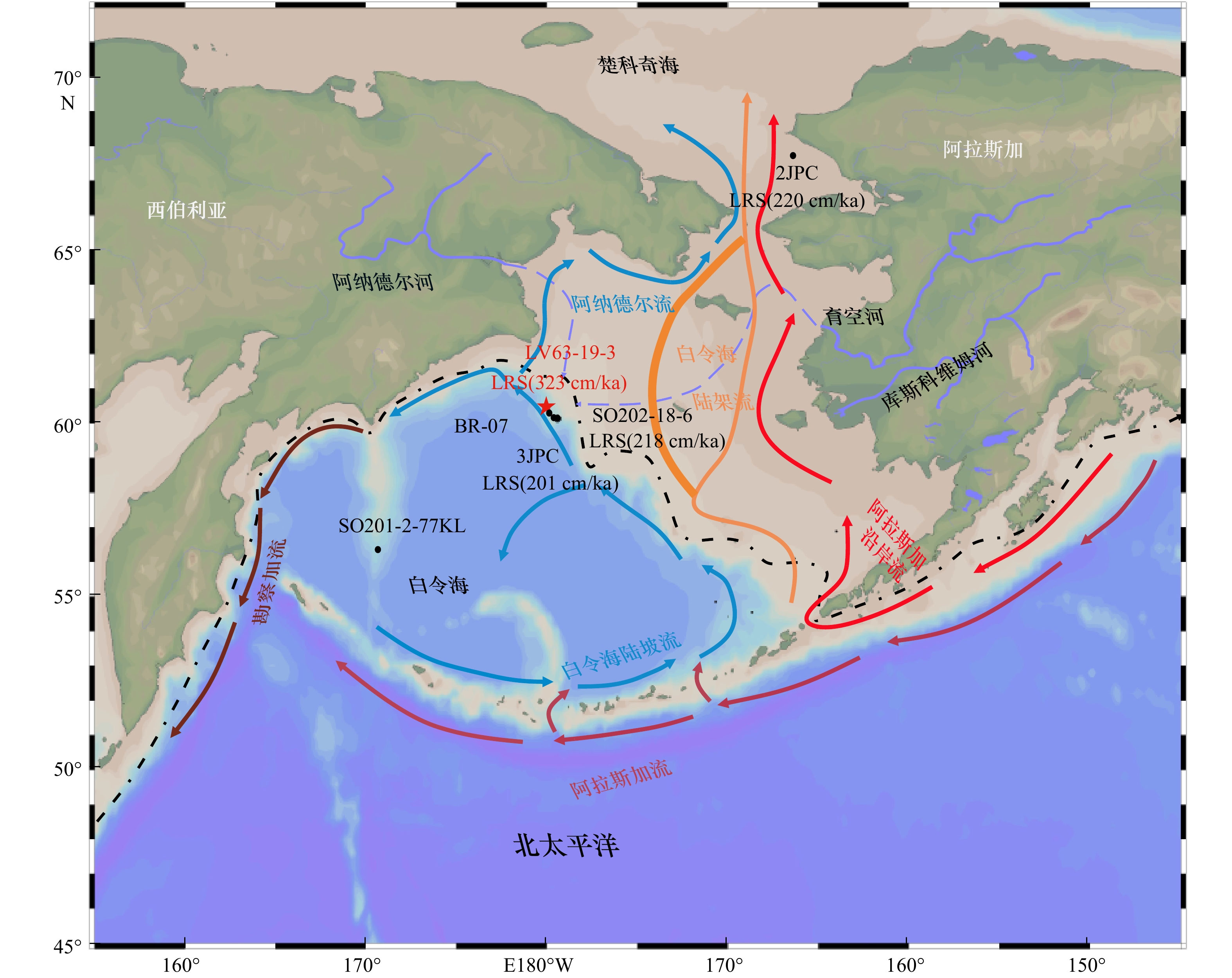
 下载:
下载:
